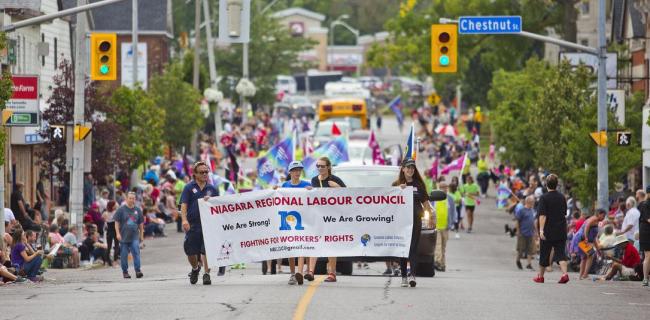Articles Menu

Sept. 5, 2020
There won’t be any Labour Day parades this weekend, due to physical distancing. Instead, trade unions in Canada will celebrate workers’ annual day with online events and other COVID-aware activities. But the absence of physical crowds should not be taken as some kind of metaphor for unions’ declining visibility. To the contrary, the pandemic actually corresponds with a surprising rebound in unions’ size and importance. There’s nothing like a crisis, it seems, to remind workers that when times are tough it helps to have a powerful ally at your back.
There were already signs of an uptick in union membership before coronavirus hit. The number of workers covered by a union contract reached an all-time high of almost five million by end-2019. As a share of total employment, union coverage rebounded slightly (after years of slow erosion) to 30.2 per cent.
During the first half of 2020, however, union coverage surged to almost 32 per cent — the highest in 15 years. To be sure, that increase was driven by a disproportionate decline in non-union employment. Union-covered workers were half as likely to lose their jobs during the initial shutdowns as non-union workers. That’s because unionized employers can’t just dispose of staff like so much excess inventory: they must follow negotiated procedures, including notice, severance, and seniority. Workers without a union — especially in precarious temporary or part-time roles — had no such protection.
The hardship experienced by workers without a union is distressing. And it highlights a gritty reality of industrial relations. In good times, unions help workers win a healthy share of a growing pie. But in bad economic times, unions really show their value. When individual businesses (or the whole economy) are in crisis, employers naturally try to shift the burden onto the workers: through layoffs, wage cuts, and other take-aways. So that is precisely when workers most need a countervailing force to represent them, and defend their past gains. Without that collective power, employers can easily make the workers pay for the crisis.
It is not surprising, then, that during tough times workers tend to particularly appreciate the benefits of union membership. Indeed, the pandemic has been associated with similar upticks in union membership and activity in several other countries, not just Canada. Union membership has increased in the U.K., Australia, and New Zealand. Even in union-hostile America, union coverage has stabilized (after many years of decline), and there has been a sharp rise in strike activity.
The COVID-19 pandemic is having terribly unequal impacts on Canadian society. It has hurt insecure and low-income workers the most, and will worsen inequality across many dimensions: including income, job security, and health. And there will be great conflicts in coming years over the shape of Canada as we rebuild after COVID-19. Familiar voices are already calling for the dismantling of emergency protections, a focus on reducing deficits, and attacking wages and conditions for public and private sector workers alike. Having the protection of a union will matter a lot as these struggles over post-COVID reconstruction unfold.
A telling parable for this moment is the current scrappy strike by 1,400 Unifor members at Dominion grocery stores (a division of Loblaw) in Newfoundland. After all, the grocery industry perfectly captures the unequal impacts of the pandemic. Grocery revenues surged thanks to panic buying and the decline in restaurant dining, and profits are strong. Retail workers were initially celebrated as “heroes” for braving infection to do their jobs, and Loblaw and other grocers even offered $2-per-hour bonuses to reward that dedication (not to mention elicit strong attendance). But as soon as the CEOs thought it was possible, they clawed back the $2.
Sure, the companies were pilloried in the media for their greed, and their executives grilled at a Parliamentary committee. But none of this hand-wringing and public complaint will get the workers back their $2. However, a determined union just might: by stopping production and imposing a cost of disagreement on the employer, it can wield real power. So if retail workers, cleaners, carers, and all the other unsung heroes of the pandemic want to protect themselves against more take-aways, and be treated fairly in post-COVID reconstruction, they need to get themselves a union. And the bounce in union membership indicates they know it.